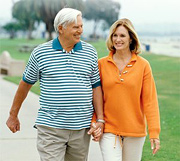Caring for the Mature Spine
Helping Seniors Enjoy Their Golden Years
By Gregory B. Sheppard, DC
A Universal ConcernIn the United States, a senior citizen is defined as someone able to retire with full Social Security benefits at age 65. Regardless of whether you have reached that age yourself, or have parents and grandparents who fit into that category, it is important to understand and appreciate the unique health problems faced by seniors - along with possible health solutions - to help serve, honor and respect those who have spent much of their lives supporting the younger generation.
Fear of Falling
I vividly remember a television commercial that aired many years ago about an elderly person who, after falling down, cried out, "Help! I've fallen, and I can't get up!" When I first saw the commercial as a young man, I must admit I found it somewhat humorous. But I have learned that seniors do not think that commercial is funny at all. Why? The reason is that most seniors have a very real fear of falling - and a much deeper fear of not being able to get up afterward. Falls are inevitable, but by staying active and physically fit, seniors can keep their spines flexible, and at the same time, maintain their strength and coordination.
 The Mature Spine
The Mature Spine
Seniors lose height in their intervertebral discs as they age because the cartilage dries out and degenerates. The spinal vertebrae (there are 26 total) get compressed and lose mass. The facet joints become arthritic. The characteristic "widow's hump" often exaggerates - especially in former office workers, accountants and bookkeepers, who spent most of their daily lives hunched over at desks.
Compression fractures commonly result in elderly patients not being able to touch their head to the pillow when lying on their back in bed. Shoulder and neck mechanics can be altered, including a stiff, restricted neck and limited shoulder motion; loss of flexibility, poor posture (skeletal misalignment and imbalance), and weak muscles (strength loss). This aging process - often combined with past traumas - results in what we as chiropractors call "subluxations."
Keeping the Spine in Shape
Believe me, restoring joint mobility and nerve function through chiropractic adjustments really works! One of the most gratifying patient encounters I have ever had occurred at a senior facility when a patient handed me his walker and said, "Doc, I want to give this to you ... because I will not be needing it anymore!" The goal for optimum senior functioning is to achieve at least 80 degrees of rotation in their neck if they are still driving, and 60 degrees of rotation if they are no longer driving. In terms of their peripheral body movement, seniors need at least 160 degrees of shoulder flexion and 60 degrees of straight-leg rising. Doctors of chiropractic can monitor a senior's range of motion and help improve spinal restrictions caused by subluxations and muscle imbalance through regular chiropractic adjustments.

